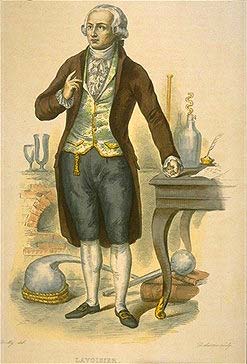| Antoine Lavoisier | |
|---|---|
 |
|
| Father of Modern Chemistry | |
| Specialty: | Chemistry, Biology |
| Born | Aug. 26, 1743 Paris, France |
| Died | May 8, 1794 (at age 50) Paris, France |
| Nationality | French |
Antoine Lavoisier was a French chemist, often referred to as “The Father of Modern Chemistry” for his influence in bringing the science to an evidence-based, measurement-centric one. He gave names to two important elements: nitrogen and oxygen. Lavoisier was the first man to draw up a lengthy list of elements, allowing him to predict the future discovery of silicon.
Aside from his scientific research, he was an important nobleman, using the income he received from this to pay for his scientific research. He was arrested and eventually executed during the French Revolution, having been accused of selling adulterated tobacco.
Early Life and Work
Lavoisier was born in Paris to a wealthy family; he became rich on a large inheritance from his mother. In 1754, he enrolled at the College Mazarin, studying botany, chemistry, mathematics, and astronomy. He left the college in 1761, publishing his first papers on chemistry three years later.
In 1767, he was employed helping to create a geological survey of the Alsace-Lorraine region, and the following year he won election to the French Academy of Sciences. He married his wife, the 13-year-old Marie-Anne, in 1771; she would play an important role in translating works from English and providing illustrations for his publications.
From 1775 onward, Lavoisier was a member of the board of the Royal Gunpowder Administration. His contributions helped to improve the quality of gunpowder used by the French military, and he also came up with a novel way of preparing saltpeter which had benefits for the country’s agriculture sector.
Lavoisier’s Experiments
He also carried out several experiments relating to combustion. He showed that oxygen was necessary for burning to take place, and that the element was also important in the respiration of living organisms, as well as being the driving force behind the formation of rust on metal. His results discredited the phlogiston theory, which had suggested that a substance of that name was released by burning objects.
Lavoisier named hydrogen, which had previously been known as “invisible air,” and showed that it combined with oxygen to make water. He corresponded with Joseph Priestley, who had previously worked on this problem, but he attempted to take all the credit for himself, a fault he displayed on other occasions, too.
Nevertheless, Lavoisier’s experiments were pioneering examples of truly quantitative experimental chemistry. In further examples, he demonstrated that the quantity of matter remains the same after it changes state, and that the weight gained by sulfur and phosphorus when burned was taken from the air; these results supported the law of matter conservation.
Chemical Nomenclature
Lavoisier drew up a nomenclature for chemistry which became the basis of the modern naming system. He gave examples for sulfur, referring to sulfuric acid, sulfites, and sulfates – all terms which remain in use. In 1789, he published his Elementary Treatise of Chemistry, which can be regarded as the first chemical textbook in a recognizably modern sense, bringing together the new theories which had emerged over the previous few years.
In the book, he gave a clear definition of an element, being a substance that was unable to be broken down by any analytical method, as well as setting out a theory of the way by which compounds could be formed. The book also contained a list of elements, including modern examples such as zinc and mercury, although light was also included.
He made a deliberate effort to bring together all of chemistry with a unified theory, making use of the idea of chemical balance. Although he was not entirely successful in his aim, Lavoisier did advance chemistry significantly by finally destroying the phlogiston theory and by introducing a structured framework for chemical nomenclature. He did make some mistakes, such as in his assertion that all acids contained oxygen, but his successes generally outweighed his failures. He underlined the general application of conservation of mass by explaining the nitrogen cycle clearly and elegantly.
Political Views and Death
Lavoisier had a lifelong interest in the study of law, and this led him to enter French politics at an early age. By the time he was 26, he had secured a position in a tax-collecting firm, the Ferme Générale. Although his occupation as a tax collector kept him occupied and made him unpopular with some of the populace, he was sufficiently idealistic to try to reform France’s taxation laws and even its entire monetary system. He also played a key role in the development of the metric system of measurement, which led to a uniform standard for weights and measures across the country.
In the Reign of Terror that followed the French Revolution itself, Lavoisier’s role as a tax collector was seen as not only immoral but actively traitorous to the revolutionary cause. In fact, he was a relative liberal by the standards of his day, but after a period of imprisonment he was sent to the guillotine in 1794.
Joseph Lagrange, one of the foremost French mathematicians of the time, said that it had been the work of a moment to remove Lavoisier’s head, but that it might be 100 years before the country produced another like it.